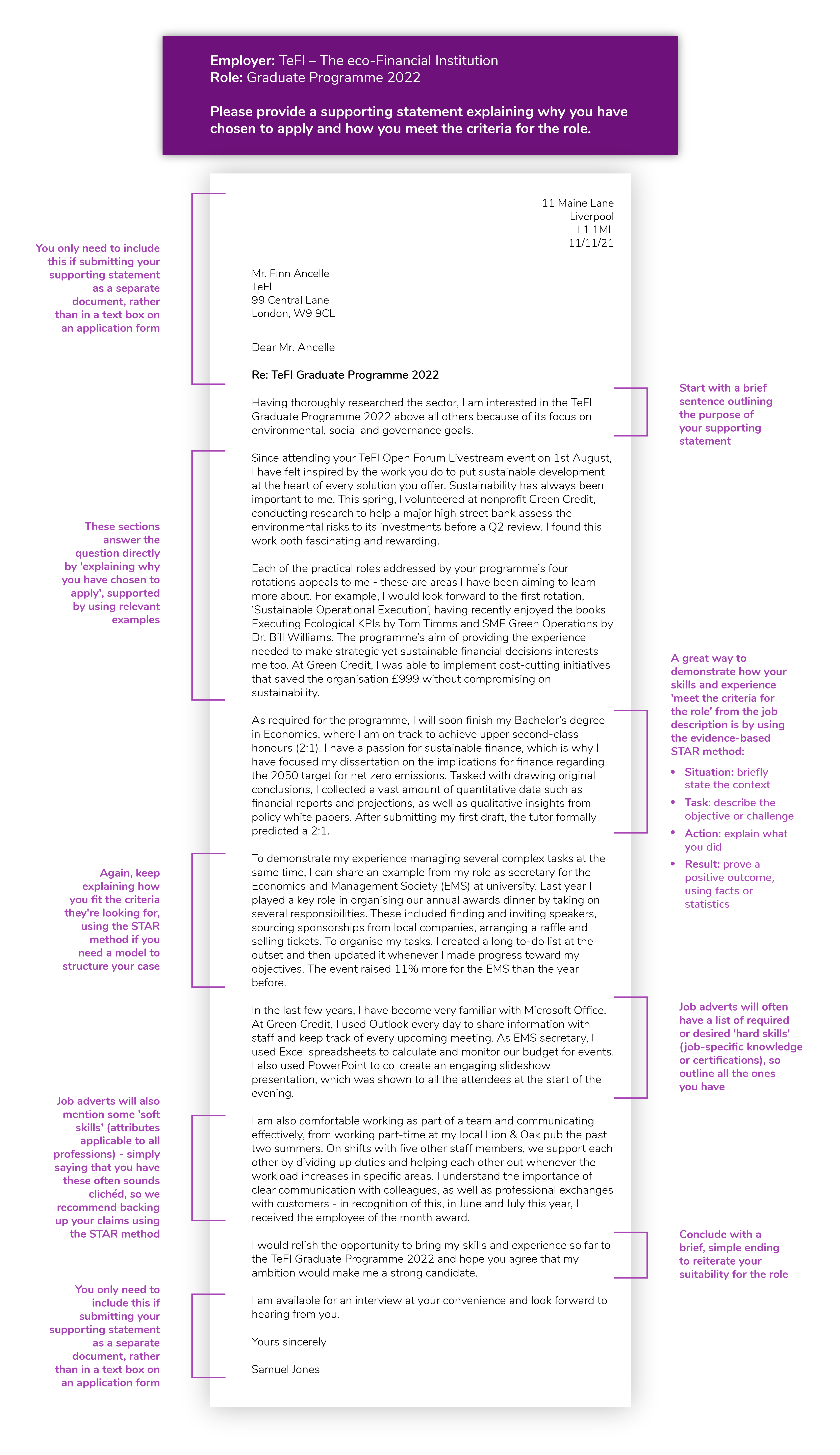Wondering how to write a supporting statement and just what makes one different from a cover letter?
The purpose of a supporting statement, like a cover letter, is to be a summary of your CV, an explanation of how your experience and skills apply to the role you are applying to, and why you want to apply to that particular role.
Look at a supporting statement as another opportunity you have to share with your potential employer why you are everything they are looking for and more as an employee.
Read on for our tips which will help you to write a stand-out supporting statement.
Key points: How to write a supporting statement
- A supporting statement highlights your skills, experience and motivation for the role — similar to a cover letter but often written directly within an application form.
- The key difference between a cover letter and a supporting statement is that the latter specifically answers a question such as “Why are you suitable for this role?”
- A strong supporting statement should demonstrate how your achievements and experience align with the employer’s needs.
- Structure your statement around the key skills listed in the job description, using real examples or projects to illustrate each point.
- Aim for 1.5 to 2 pages in length unless a specific word or character limit is provided by the employer.
- Always tailor each supporting statement to the individual role — customisation shows genuine interest and research.
- Proofread carefully and maintain a professional, confident tone to leave a lasting impression on the hiring manager.
Supporting statement vs cover letter
As previously stated, supporting statements are extremely similar to cover letters, so let’s discuss a supporting statement versus a cover letter and why the distinction is important.
Both cover letters and supporting statements explain to your potential employer why you are applying to a role and what skills, knowledge, and experience you have that will help you find success in the role.
The main difference is that a cover letter is usually a separate document that is sent with your CV while a supporting statement is included in the application form and answers a statement like “please explain why you are perfect for this role”.
How to write a supporting statement
A supporting statement needs to explain why you are the perfect for the role you are applying for by illustrating how your past experiences, skills and achievements provide evidence you’ll excel in the role.
You need to write a supporting statement that speaks directly to the employer’s wants and needs and here are some tips on how to write a supporting statement so it does just that.
The first step, and perhaps the most important step, is figuring out what the employer wants from the supporting statement.
Some employers will ask you to explain why you are suitable for the role while others may ask you why you are applying and why you want to be hired.
The second step is to figure out the best way to structure the supporting statement so that you show how you have the key skills highlighted in the job description.
The third step is to decide how you want to describe the skills you possess.
This might be done by highlighting a project that allowed you to exercise a specific skill or a presentation that allowed you to put multiple skills into practice.
How long should a supporting statement be?
Finding a balance for the length of your supporting statement is important so that you take advantage of the opportunity to promote yourself, but don’t waffle.
The easiest way to know how long you should make your supporting statement is if the employer specifies a character or word limit.
However, if there is no word limit, a good supporting statement length is no more than two pages, with 1.5 pages being a good target.
This length allows you to share all your competencies in a concise and focused way that will ensure that employers will keep their attention on your supporting statement.
Answer the question
When you are writing a supporting statement, especially when it is a section on the job application form, you need to make sure that you are expressly answering what the employer is asking.
As previously stated, sometimes applications will ask questions like ‘what skills do you have that make you the perfect match for this role?’, but others may ask why you want the role or why you’re suitable for the role.
As such, you’ll need to write a custom supporting statement for each job you apply for, making sure your response is tailored to the question at hand and the individual job description.
Making a custom supporting statement also shows that you took the time to research the company you are applying for and shows just how interested you really are in the role.
Supporting statement template
Below is an annotated supporting statement template to demonstrate the best practices for writing and formatting.

FAQs: How to write a supporting statement
What is an example of a supporting statement for a job application?
A supporting statement might read: “I am an organised, motivated professional with over five years of experience in customer service. My ability to communicate effectively and handle complex queries aligns perfectly with this role’s requirements. I’m passionate about delivering excellent service and would welcome the opportunity to contribute to your team’s success.”
What is the opening sentence of a supporting statement?
A good opening sentence should immediately state your enthusiasm and suitability for the role. For example: “I’m excited to apply for this position as it perfectly matches my skills, experience and passion for professional development.”
What is an example of a supporting statement for a support worker?
I am a compassionate and reliable individual with three years’ experience supporting adults with learning disabilities. I take pride in promoting independence, ensuring dignity and creating a safe, supportive environment that enhances quality of life.” This example demonstrates empathy and relevant experience, two essential traits for a support worker role.
What is a good example of a statement?
A good statement is concise, specific and tailored to the job. For example: “With a background in administration and strong attention to detail, I have consistently delivered efficient support that helps teams achieve their goals.”
What can I say to support my application?
You can strengthen your application by highlighting your most relevant experience, achievements and transferable skills. Mention how your background aligns with the company’s values and goals, and express enthusiasm for contributing to their success. Always focus on what value you’ll bring to the role.
How to write a supporting statement for a job application: In summary
Essentially, to write a strong supporting statement, you should know what makes you the best applicant for the job, and convey that to the employer.
A custom supporting statement directly answering the question set by the employer is the perfect way to grab their attention and help you get your dream job.
We hope you enjoyed this blog. For more insights and guidance, take a look at the following articles:
- Soft Skills: What They Are And How To Highlight Them
- How To Write A Retail Assistant Cover Letter That Gets Read
- How To Write A Career Change Cover Letter That Gets Read
- How To End A Cover Letter: Examples Of The Perfect Cover Letter Ending
- How To Address A Cover Letter With Real Life Examples
- How To Write A Supporting Statement For A Job Application With Template
- How To Write a Cover Letter For An Internship
At PurpleCV, we understand how important it is to stand out and we can help you create the perfect supporting statement that will impress any potential employer. Please contact us to find out more.


